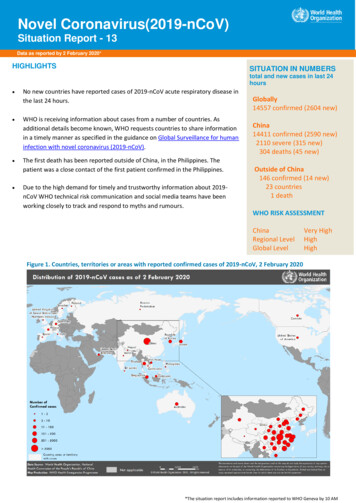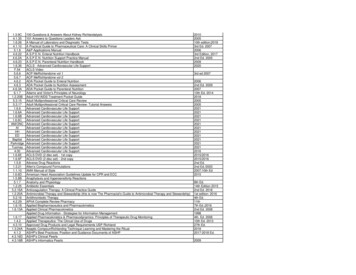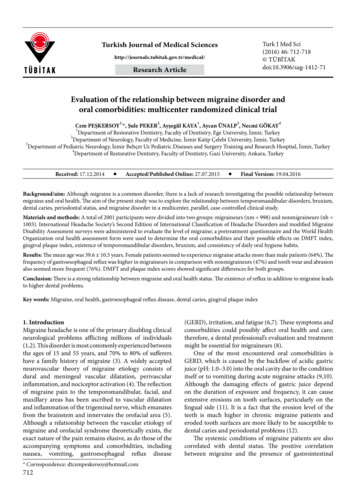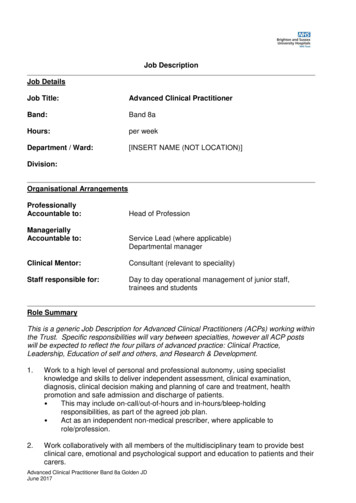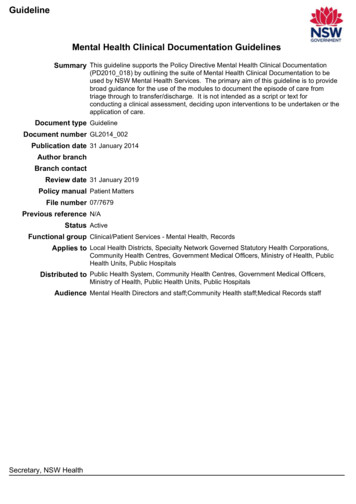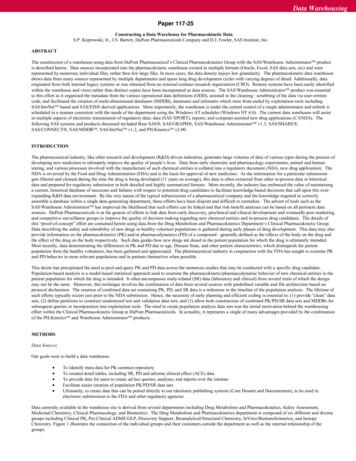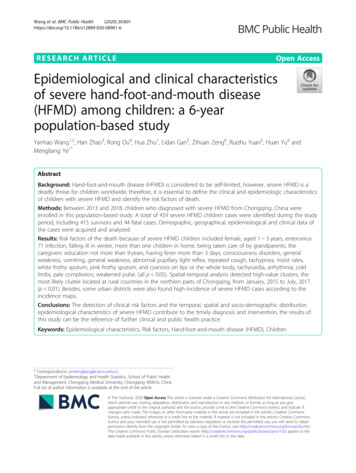
Transcription
Wang et al. BMC Public Health(2020) SEARCH ARTICLEOpen AccessEpidemiological and clinical characteristicsof severe hand-foot-and-mouth disease(HFMD) among children: a 6-yearpopulation-based studyYanhao Wang1,2, Han Zhao3, Rong Ou4, Hua Zhu1, Lidan Gan5, Zihuan Zeng6, Ruizhu Yuan6, Huan Yu6 andMengliang Ye1*AbstractBackground: Hand-foot-and-mouth disease (HFMD) is considered to be self-limited, however, severe HFMD is adeadly threat for children worldwide, therefore, it is essential to define the clinical and epidemiologic characteristicsof children with severe HFMD and identify the risk factors of death.Methods: Between 2013 and 2018, children who diagnosed with severe HFMD from Chongqing, China wereenrolled in this population-based study. A total of 459 severe HFMD children cases were identified during the studyperiod, including 415 survivors and 44 fatal cases. Demographic, geographical, epidemiological and clinical data ofthe cases were acquired and analyzed.Results: Risk factors of the death because of severe HFMD children included female, aged 1 3 years, enterovirus71 infection, falling ill in winter, more than one children in home, being taken care of by grandparents, thecaregivers’ education not more than 9 years, having fever more than 3 days, consciousness disorders, generalweakness, vomiting, general weakness, abnormal pupillary light reflex, repeated cough, tachypnea, moist rales,white frothy sputum, pink frothy sputum, and cyanosis on lips or the whole body, tachycardia, arrhythmia, coldlimbs, pale complexion, weakened pulse. (all p 0.05). Spatial-temporal analysis detected high-value clusters, themost likely cluster located at rural countries in the northern parts of Chongqing, from January, 2015 to July, 2017.(p 0.01). Besides, some urban districts were also found high incidence of severe HFMD cases according to theincidence maps.Conclusions: The detection of clinical risk factors and the temporal, spatial and socio-demographic distributionepidemiological characteristics of severe HFMD contribute to the timely diagnosis and intervention, the results ofthis study can be the reference of further clinical and public health practice.Keywords: Epidemiological characteristics, Risk factors, Hand-foot-and-mouth disease (HFMD), Children* Correspondence: yemengliang@cqmu.edu.cn1Department of Epidemiology and Health Statistics, School of Public Healthand Management, Chongqing Medical University, Chongqing 400016, ChinaFull list of author information is available at the end of the article The Author(s). 2020 Open Access This article is licensed under a Creative Commons Attribution 4.0 International License,which permits use, sharing, adaptation, distribution and reproduction in any medium or format, as long as you giveappropriate credit to the original author(s) and the source, provide a link to the Creative Commons licence, and indicate ifchanges were made. The images or other third party material in this article are included in the article's Creative Commonslicence, unless indicated otherwise in a credit line to the material. If material is not included in the article's Creative Commonslicence and your intended use is not permitted by statutory regulation or exceeds the permitted use, you will need to obtainpermission directly from the copyright holder. To view a copy of this licence, visit http://creativecommons.org/licenses/by/4.0/.The Creative Commons Public Domain Dedication waiver ) applies to thedata made available in this article, unless otherwise stated in a credit line to the data.
Wang et al. BMC Public Health(2020) 20:801BackgroundAs a common infectious disease among children, handfoot-mouth disease (HFMD) has aroused wide attentionall over the world [1–5]. HFMD is mainly caused by agroup of enterovirus, mainly by enterovirus 71(EV71)and coxsackie virus A16 (Cox A16) [4, 6–8], it is characterized by fever, oral ulcers, and skin eruptions onhands, feet, buttocks [9–11], and transmission occursthrough the direct contact with saliva, feces, vesicularfluid, or respiratory droplets of the infected individual,and indirectly by contaminated articles [12, 13].Generally, the state of HFMD is mild and self-limited.However, many countries or regions have experiencedpandemics of severe or fatal HFMD cases in recentyears, especially Asia-Pacific countries [14–18]. ForChina, HFMD is also a major public health problem,and the study of Xing W, et al. showed that about 500 900 people in China died because of the severe HFMDevery year, mainly in children [1], and the mortality rateamong children with severe HFMD is also high worldwide [19–22]. Severe HFMD poses a great threat toone’s health and life, especially the child, as well asbringing psychological and financial burden burdens forfamilies, therefore, the research and investigation of severe HFMD are important.Previous studies about HFMD were mainly focused onthe features of mild HFMD, therefore, the incidence ofHFMD worldwide has been controlled to a certain degree[23–25]. However, to our knowledge, relevant researchesabout the clinical or epidemiological characteristics of severe HFMD patients or fatal cases was few, which may impede the further reduction in case fatality. SinceChongqing is one of the districts in China affected by theoutbreaks of severe HFMD [1, 24] and studies have shownthe incidence of HFMD in Chongqing was higher than thenational incidence, as well as that in many countries or regions [24], the present study aimed to investigate the clinical and epidemiological characteristics of severe HFMDand identify risk factors of severe HFMD in our population by taking Chongqing as an example, which may provide theoretical support for further prevention, diagnosisand treatment of severe HFMD.MethodsClinical definitionA clinical case of HFMD was defined as a patient withmaculopapular or vesicular rash on hands, feet, mouth, orbuttocks, with or without fever, according to the guidelines of the National Health Commission of the People’sRepublic of China [26]. Children (aged 0–17 years) werediagnosed with severe HFMD if they developed at leastone of the following: cardiopulmonary collapse, pulmonary hemorrhage, pulmonary edema, encephalitis, asepticPage 2 of 11meningitis, acute flaccid paralysis, myocarditis, or death[27–30].Data collectionOn 2 May2008, HFMD became a notifiable disease as aClass C (third level of severity and importance of publichealth) infectious disease in mainland China. Since then,all HFMD cases diagnosed in hospitals were reported to“National Disease Reporting Information System”(NDRIS) within 24 h after diagnoses, including hospitalized and ambulatory cases, not only referred cases, butalso self-presenting cases, according to the requirementof the law of the People’s Republic of China on Prevention and Treatment of Infectious Diseases [23]. Therefore, we analyzed the clinical and epidemiological dataof severe HFMD children patients from 1 January 2013to 31 December 2018 in Chongqing.Specimen collection and laboratory testingAppropriate clinical specimens from the severe HFMDcases, including fecal sample, rectal swab, throat swab,vesicular fluid, and/or cerebrospinal fluid, were collected.Specimens were placed in 3 mL of sterile viral transportmedium and sent to biosafety level two facilities for RTPCR test within 48 h of collection, using commerciallyavailable pan-enterovirus, EV71, and Cox A16 diagnostickits, according to standardized protocols disseminatedby the National Center for Disease Control and Prevention (CDC) [23].Statistical analysisThe study site is Chongqing, which is located in southwest of China, lying between latitude 28 10′-32 13′ Nand longitude 105 11′-110 11′ E. (Fig. 1). The incidencerates of severe HFMD were computed at district leveland colored with different colors in the incidence mapusing the software ArcGIS10.2 (ESRI, Redlands, CA,USA) to show the spatial distribution of severe HFMD.The incidence data of severe HFMD from 2013 to 2018were used for retrospective spatiotemporal analysis. Thesize of the maximum spatial cluster was defined as a circlewith a radius of 92.87 km. The method is based on thegeographic coordinates to establish a two-dimensionalwindow of the cylinder. The base circle of the cylinderrepresents the geographical range and the height represents the length of time. The position and height of thecylinder are dynamically changing. Log likelihood ratio(LLR) was used as the index to measure the abnormal degree of severe HFMD in the scanning window and theMonte Carlo method was used to test LLR for p values.When P 0.05, we thought that the statistical index of thescanning window compared with outside the window, therelative risk (relative risk, RR) was statistically significant.Parameters were set as: no geographical region overlap,
Wang et al. BMC Public Health(2020) 20:801Page 3 of 11Fig. 1 The distribution of districts and counties in Chongqing, China and its location. The study site is Chongqing, which is located in southwestof China, lying between latitude 28 10′-32 13′ N and longitude 105 11′-110 11′ E.The maps depicted in Fig. 1 were taken from National Geomatics Center of China. (http://www.ngcc.cn/ngcc/)20% of population at risk, time length was limited to 1month, and the number of Monte Carlo replication was999. The areas with the largest LLR values obtained fromthe scan are called the most significant, and the remainingstatistically significant aggregation areas are called secondary potential clusters.The statistical analyses of clinical data were performedbetween the fatal cases and survivors using the SPSS software version 19.0 (IBM Corporation, Armonk, NY). Weused the chi-square test for analyzing categorical data.General characteristics, family characteristics, symptoms,complications were compared in the two groups, and weperformed conditional univariable logistic regression tofind predictors that were discriminatory for the death because of severe HFMD [19, 31]. The level of statistical significance for all analyses was P 0.05.Ethics statementAll the study procedures were reviewed and approved by theEthics Committee of Chongqing Center for Disease Controland Prevention. All individual identifying information suchas name, address, and telephone number, etc. was anonymized and de-identified prior to analysis. Informed consentswere obtained from the individuals or their guardian beforethe information and the specimens were collected.including 415 survivors and 44 fatal cases. The mean ageof the patients was 2.15 years (range from 1 months to16 years), and the ratio of male to female was 1.8:1.Table 1 outlines the general characteristics of all casesincluding gender, age, the hosting classification of children, identification of enterovirus and the onset season.Overall, female children (odds ratio (OR) 1.92, 95%confidence interval (CI) 1.03–3.59, P 0.05) and thechildren aged 1 to 3(OR 2.71, 95%CI 1.23–5.98, P 0.01) are easier to die of severe HFMD. Enterovirus 71infection (OR 1.97, 95%CI 1.02–3.83, P 0.05) andfalling ill in winter (OR 2.88, 95%CI 1.28–6.49, P 0.05) are the risk factors for death. The influence ofhosting classification on mortality was not statisticallysignificant. (Table 1.)The poor prognosis (death) may associated with morethan one children in the children patient’s home (OR 2.69, 95%CI 1.17–6.19, P 0.05), being taken care of bygrandparents (OR 2.40, 95%CI 1.28–4.49, P 0.01)and the caregivers’ education not more than 9 years(OR 5.52, 95%CI 2.13–14.29, P 0.01). Besides, thechildren patients whose neighborhood also suffer fromHFMD disease, may have a better chance of survival(OR 0.14, 95%CI 0.02–1.01, P 0.01). (Table 1.)Symptoms, and signsResultsGeneral characteristicsA total of 459 severe HFMD cases among children wereidentified during the study period (2013 2018),Table 2 shows that the children with severe HFMD whohaving fever more than 3 days (OR 2.27, 95%CI 1.14–4.54, P 0.05) are easier to die. However, the children patients who had rash more than 3 days (OR
Wang et al. BMC Public Health(2020) 20:801Page 4 of 11Table 1 Demographic characteristics of severe HFMD children patientsFatal casesN2 44SurvivorsN1 415TotalN 459OR (95%CI)Male22 (50.0)273 (65.8)295 (64.3)0.52 (0.28–0.97)*Female22 (50.0)142 (34.2)164 (35.7)Referent 14 (9.1)47 (11.3)51 (11.1)0.78 (0.27–2.29)1 36 (81.8)259 (62.4)295 (64.3)2.71 (1.23–5.98)**3 3 (6.8)97 (23.4)100 (21.8)0.24 (0.07–0.79)* 51 (2.3)12 (2.9)13 (2.8)ReferentGenderAgeHosting ClassificationScatter children a36 (81.8)333 (80.2)369 (80.4)1.11 (0.50–2.47)Childcare b8 (18.2)75 (18.1)83 (18.1)1.01 (0.45–2.26)In school c0 (0.0)3 (0.7)3 (0.7)–Others0 (0.0)4 (1.0)4 (0.9)–EV7130 (68.2)216 (52.0)246 (53.6)1.97 (1.02–3.83)*Cox A160 (0.0)14 (3.4)14 (3.1)–Other enterovirus4 (9.1)66 (15.9)70 (15.3)0.53 (0.18–1.53)Negative10 (22.7)119 (28.7)129 (28.1)0.73 (0.35–1.53)Winter9 (20.5)34 (8.2)43 (9.4)2.88 (1.28–6.49)*Autumn3 (6.8)37 (8.9)40 (8.7)0.75 (0.22–2.53)Summer12 (27.3)173 (41.7)185 (40.3)0.53 (0.26–1.05)Spring20 (45.5)171 (37.3)191 (41.6)1.19 (0.64–2.22)Family members, 328 (63.6)299 (72.0)327 (71.2)0.68 (0.35–1.30)Children in home, 137 (84.1)275 (66.3)312 (68.0)2.69 (1.17–6.19)*Parents21 (47.7)285 (68.7)306 (66.7)0.42 (0.22–0.78)*Grandparents23 (52.3)130 (31.3)153 (33.3)ReferentIdentification of enterovirusOnset seasonCaregiversCaregivers’ education 9 y5 (11.4)172 (41.4)177 (38.6)0.18 (0.07–0.47)**0–9 y39 (88.6)243 (58.6)282 (61.5)ReferentNeighborhood children also suffer from HFMD disease1 (2.3)50 (12.0)51 (11.1)0.14 (0.02–1.01)*Note: OR Odds ratio, CI Confidence interval. *P 0.05; ** P 0.010.50, 95%CI 0.26–0.96, P 0.05), or who were foundherpes in the oral cavity (OR 0.43, 95%CI 0.23–0.80,P 0.05) or on cheek (OR 0.22, 95%CI 0.09–0.58,P 0.05), had a better prognosis. (Table 2.)Clinical complicationsThe fatal cases had a higher incidence of consciousnessdisorders (OR 8.22, 95%CI 4.22–16.02, P 0.01), abnormal pupillary light reflex (OR 5.96, 95%CI 2.66–13.34, P 0.01), vomiting (OR 3.23, 95%CI 1.72–6.08,P 0.01), and general weakness (OR 2.51, 95%CI 1.22–5.16, P 0.05), compared with the survivors.Lethargy, convulsion and dysphoria were not significantly associated with a fatal course. (Table 2.)The fatal cases had a higher incidence of some respiratory and circulatory complications, such as persistentcough (OR 2.63, 95%CI 1.07–3.98, P 0.05), tachypnea (OR 2.40, 95%CI 1.28–4.49, P 0.01), Moist rales(OR 7.13, 95%CI 3.61–14.06, P 0.01), White frothysputum (OR 4.05, 95%CI 1.22–13.50, P 0.05), pinkfrothy sputum (OR 21.77, 95%CI 9.78–48.44, P 0.01), lips cyanosis (OR 12.82, 95%CI 6.09–29.96,P 0.01), the whole body cyanosis (OR 5.80, 95%CI 2.73–13.30, P 0.01), increased heart rate (OR 2.14,
Wang et al. BMC Public Health(2020) 20:801Page 5 of 11Table 2 The comparison on general symptoms and nervous, respiratory and circulatory complications between survivors and fatalcasesFatal casesN2 44SurvivorsN1 415TotalN 459OR(95%CI)Fever42 (95.5)396 (95.4)438 (95.4)1.01 (0.23–4.48)Hyperpyrexia(T 39 C)9 (20.5)102 (24.6)111 (24.0)0.79 (0.37–1.70)Fever 3 days32 (72.7)224 (54.0)286 (62.3)2.27 (1.14–4.54)*Rash36 (81.8)373 (90.0)409 (89.1)0.51 (0.22–1.16)Rash 3 days16 (36.4)221 (53.3)237 (51.6)0.50 (0.26–0.96)*Herpes in the oral cavity22 (50.0)291 (70.1)313 (68.2)0.43 (0.23–0.80)*Herpes on cheek5 (11.4)152 (36.6)157 (34.2)0.22 (0.09–0.58)*Herpes on fauces14 (31.8)126 (30.4)140 (30.5)1.07 (0.55–2.09)Consciousness Disorders22 (50.0)45678.22 (4.22–16.02)**Lethargy33 (75.0)3073401.06 (0.52–2.16)Abnormal pupillary light reflex11 (25.0)22335.96 (2.66–13.34)**Panic262702960.78 (0.41–1.46)Vomiting231051283.23 (1.72–6.08)**Convulsion1390511.51 (0.76–3.01)General weakness1050602.51 (1.22–5.16)*Dysphoria964731.41 (0.65–3.08)Shake of hand or foot192122310.73 (0.39–1.36)Persistent cough16901062.63 (1.07–3.98)*Polypnea955641.68 (0.77–3.69)Tachypnea1430425.99 (2.87–12.49)**Moist rales1940597.13 (3.61–14.06)**White frothy sputum410144.05 (1.22–13.50)*Pink frothy sputum19143321.77 (9.78–48.44)**Cyanosis (lips)348712112.82 (6.09–26.96)**Cyanosis (the whole body)1328415.80 (2.73–13.30)**Tachycardia25 (56.8)158 (38.1)1832.14 (1.14–4.01)*Arrhythmia13 (29.5)25 (6.0)386.54 (3.05–14.04)**Cold limbs17 (38.6)42 (10.1)595.59 (2.82–11.10)**Pale complexion18 (40.9)48 (11.6)665.29 (2.70–10.37)**Weakened pulse14 (31.8)23 (5.5)377.95 (3.72–14.03)**Nervous complicationsRespiratory complicationsCirculatory complicationsNote: OR odds ratio; CI confidence interval. *P 0.05, ** P 0.0195%CI 1.14–4.01, P 0.05), arrhythmia (OR 6.54,95%CI 3.05–14.04, P 0.01), cold limbs (OR 5.59,95%CI 2.82–11.10, P 0.01), pale complexion (OR 5.29, 95%CI 2.70–10.37, P 0.01) and weakened pulse(OR 7.95, 95%CI 3.72–14.03, P 0.01). (Table 2.)commonly seen in the spring or summer, the highestnumber of cases reported was in the spring of 2015, andthe second highest was in the summer of 2017. Fatalcases could be seen in for seasons. (Fig. 2.)Spatial distribution of severe HFMDTemporal distribution of severe HFMDFigure 2 shows the temporal (seasonal) distribution ofsevere HFMD children from the spring of 2013 to thewinter of 2018. Epidemic peaks of severe HFMD wereFrom 2013 to 2018, a total of 459 cases of severe HFMDchildren were discovered in Chongqing, covering 38 regions, with a total population of 2944, 9983 and an incidence rate of 0.3/100,000. Figure 3 shows the annual
Wang et al. BMC Public Health(2020) 20:801Page 6 of 11Fig. 2 Seasonal distribution of severe HFMD children (survivors and fatal cases). Epidemic peaks of severe HFMD were commonly seen in thespring or summer, the highest number of cases reported was in the spring of 2015, and the second highest was in the summer of 2017. Fatalcases could be seen in for seasonsincidence of severe HFMD from 2013 to 2018. In thestudy period, the incidence of HFMD in Chongqing wasrandomly distributed as a whole. According to the analysis of the incidence of HFMD in Chongqing, the firstthree high incidence counties were Fuling, Kaixian andWanzhou successively. (Fig. 3.)The results showed that the higher incidence areas(dark orange) were mainly located in the northeast regions (Kaixian, Wanzhou, Wuxi, Liangping) except 2014and 2018. In 2014, the highest incidence region wasXiushan which was on the far southeast, and higher incidence areas (light orange and yellow) varied each yearand spread all over the municipality except 2018. Mostof the areas with relatively high incidence were concentrated in the northeast, while the incidence in the southis relatively low. Overall, the thematic map of the annualincidence indicated that the northeast and middle partsof Chongqing were still the high incidence regions ofHFMD, especially some counties such as Kaixian, Fuling,Wuxi, Liangping, Xiushan. Furthermore, 2013, 2015and2017 were the relatively severe years of HFMD epidemic.(Fig. 3.)Spatial-temporal clustersTable 3 listed the scanning results of most likely clustersfor serve HFMD cases derived from the retrospectiveSpatial-Temporal analysis. P 0.05 and the higher valueof LLR, the higher risk of disease exists in the scanningwindow, and the window is more likely a cluster. Therewere 10 spatiotemporal aggregation regions with statistical significance (P 0.05), including 6 from 2015 to2017 and 4 in 2018. The most likely cluster was Kaixian,Yunyang, Wanzhou, Chengkou and Liangping fromJanuary, 2015 to July, 2017. During this period, the expected cases in this area was 30.86, but the actual number was 153, with a relative risk of 6.93, and P 0.05.Secondly, the clusters centered in Fuling district fromMarch to July in 2015, and four main urban districts(Yuzhong, Nanan, Dadukou and Jiangbei) in July 2018.(Table 3.)In Fig. 4, the most likely cluster was shown in redcolor on the map, the secondary cluster was in pinkcolor and the 2nd secondary cluster was in orange color.The three clusters in our study were near the YangtzeRiver basin. (Fig. 4.)DiscussionSevere hand-foot-mouth disease progresses rapidly andmay develop severe complications which could be lifethreatening [32–35]. Therefore, screening children withsevere HFMD for the abnormal vital signs is importantin predicting impending deadly complications and allowing the timely initiation of appropriate interventions[31]. This study aims to describe the clinical and
Wang et al. BMC Public Health(2020) 20:801Page 7 of 11Fig. 3 Spatial distribution of severe HFMD children (survivors and fatal cases). Overall, the thematic map of the annual incidence indicated thatthe northeast and middle parts of Chongqing were still the high incidence regions of HFMD, especially some counties such as Kaixian, Fuling,Wuxi, Liangping, Xiushan. Furthermore, 2013, 2015and 2017 were the relatively severe years of HFMD epidemic. The maps depicted in Fig. 3 weretaken from National Geomatics Center of China. (http://www.ngcc.cn/ngcc/)epidemiological features of severe hand-foot-and-mouthdisease and identify the risk factors of death in severeHFMD children.Among the five general characteristics in this study,aged 1 3 years, enterovirus type 71 infections and failing ill in winter, were the risk factors for the death. Similar to previous reports, in this study, most of thechildren patients of severe HFMD were under 3 yearsold, which is probably because the immune function ofthese children are not yet mature [36–38]. Enterovirus71 infection is the main strain of severe and fatal HFMDall over the world [39–41]. Analogously, children withEV71 infection accounted for a relatively high proportion of fatal cases in this study, which may be related tothe virulence and pathogenicity of EV71 [4]. EV71 wasreported to be strongly neurotropic, it can cause damageto cerebral cortex, pons, brainstem, cerebellum andspinal cord [42]. And the injury of central nervous system can cause the abnormality of sympathetic nerve activity, causing clinical symptoms like consciousnessdisorders, convulsion, etc., while the blood pressure andthe heart rate of the patient also change [10]. However,the onset of EV-71 infection was reported to be insidious and cause rapid progression of neurological damage,Table 3 The scanning results of Spatial-Temporal Clusters for serve HFMD cases among children in Chongqing, 2013–2018Cluster typeTime (km2)RRLLRMost likely2015/1–2017/7515330.8692.876.93142.123460 Kaixian, Yunyang, Wanzhou, 47.58 141.361975 Fuling0.001*2ndSecondary2018.74110.5417.5520.75 22.7669410.001*Note: LLR Log likelihood ratio, RR Relative risk. * p 0.01Specific districtsYuzhong, Nanan, Dadukou. Jiangbeip0.001*
Wang et al. BMC Public Health(2020) 20:801Page 8 of 11Fig. 4 Spatial clusters of severe HFMD in Chongqing, China from 2013 to 2018. The space scan proposed by Kulldorff is integrated in SaTScan TMv9.4 (http://www.satscan.org/) and clusters are depicted on the map using the software ArcGIS10.2 (https://www.arcgis.com/features/index.html,ESRI, Inc., Redlands, CA, USA). Note: The most likely cluster was shown in red color on the map, the secondary cluster was in pink color and the2nd secondary cluster was in orange color. The blue curve on the map represents the trunk of the Yangtze River. The map depicted in Fig. 4were taken from National Geomatics Center of China. (http://www.ngcc.cn/ngcc/)sometimes it can lead to death within the day of detecting neurological complications [36]. Therefore, theneurological abnormalities in children with severeHFMD should be paid attention to, and the developmentof EV71 detection methods with high sensitivity are alsoneeded. Moreover, it is worth noting that in this study,although the incidence of severe HFMD is higher insummer or spring, the mortality rate is higher in winter,which indicates that attention should be paid to thetimely detection and treatment of HFMD in winter.Among the five family characteristics, more than onechildren in home, being taken care of by grandparentsand the caregivers’ education not more than 9 years,were the risk factors for the death of severe HFMD,while neighborhood children having HFMD disease, being taken care of by parents and caregivers’ educationmore than 9 years were the protective factors of the poorprognosis (death). These results indicate that the timelydetection of severe HFMD is important and family caregivers need to be educated about hand-foot-mouth disease and related symptoms.In the analysis of general symptoms or signs ofHFMD, having fever more than 3 days is the risk factorof poor prognosis, while having rash more than 3 days,having herpes in the oral cavity or on cheek may be theprotective factors, the reason is probably because peopleare more likely to initially diagnose HFMD by findingthe rash. In the analysis of neurological complications,consciousness disorders, vomiting, abnormal pupillarylight reflex, general weakness were associated with thedeath because of severe HFMD. When focused on respiratory complications, seven risk factors were identified to be the factors associated with the poor prognosisin this study, namely the presence of repeated cough,tachypnea, moist rales, white frothy sputum, pink frothysputum, and cyanosis on lips or the whole body. In theanalysis of circulatory complications, tachycardia,arrhythmia, cold limbs, pale complexion, weakened pulsewere reported as predictive factors for a fatal course ofsevere HFMD.Researches mainly attributed the death of severeHFMD to refractory heart failure and neurogenic pulmonary edema (NPE) [43–45]. At present, the mechanism of NPE is thought to be caused by specific injury inbrainstem or medulla oblongata and inflammatory response [32, 46, 47]. Central nervous system lesions andinflammatory response can increase the intracranialpressure, which causes dysfunction of the optic hypothalamus and medullary solitary tract nucleus and complications such as vomiting, consciousness disorders,Convulsion, excessive sympathetic excitation, etc. occur.Then the level of serum catecholamine (epinephrine,norepinephrine, etc.) was significantly increased, so systemic vasoconstriction and hemodynamic changessharply, systemic circulation resistance and arterial bloodpressure increase sharply, and left ventricular ejectionwill reduce, then large amounts of blood flow from thesystemic circulation will enter into the pulmonary circulation, the effective filtration pressure of pulmonary capillary will increase rapidly, and a large amount of fluid
Wang et al. BMC Public Health(2020) 20:801retention in the lung tissue clearance, causing severepulmonary edema. Blood flow impact may induced vascular endothelial cell damage, vasoactive substances likehistamine and bradykinin are released in large quantities,then vascular permeability increased and the plasma extravasation is massive, which intensifying the degree ofpulmonary edema. After the occurrence of NPE, the ratio imbalance of receptors alpha and beta in lung tissueoccurs under the excitement of sympathetic nervous, inducing the increase of the vascular permeability, as a result, inflammatory mediators such as IL-10, IL-13, IFN-γwill cause the increase of alveolar exudation, which further aggravates pulmonary edema and heart failure [48,49]. Through the analysis of NPE mechanism, combinedwith the results of this study, the neurological complications might be the timely predictive factors of poorprognosis, especially consciousness disorders, generalweakness, abnormal pupillary light reflex, and some respiratory and circulatory complications are thought tobe the warning signal for severe HFMD children, such aswhite frothy sputum, pink frothy sputum, tachypnea,cyanosis on lips or the whole body; moist rales, tachycardia,arrhythmia, cold limbs, pale complexion, and weakened pulse.Spatial aggregation of disease means that the risk of disease is significantly higher in some regions than in others.Spatial-Temporal scanning included population variables,that’s is to say, corrected the non-uniform populationdensity in different places, and detected the clustering ofcases in both time and space dimensions by moving window method. Through analyzing the severe HFMD casesfrom 2013 to 2018 in Chongqing, by using space-timescan, found that the clusters were mainly concentrated inKaixian in 2013, Xiushan in 2014, Fuling and Wanzhou in2015, and in 2017, mainly concentrated in the Wuxi andLiangping, and it is interesting to note that these areas aremainly concentrated near the Yangtze River basin, whichindicates that the prevalence of severe HFMD may be associated with the flow of population, water pollution orother factors related to the river. From the perspective ofoverall incidence, the results showed that, the incidence ofsevere HFMD was relatively high in 2013, 2015 and 2017,and significantly decreased in 2014, 2016 and 2018, whichmay be due to the medical and economic conditions indifferent regions, showing a cyclical change of decreaseand increase, and the prevention and control situation issevere.As an exploratory analysis, the spatial-temporal scanning method objectively demonstrated the spatial andtemporal regularity of the severe HFMD, and well evaluated the abnormal increase of HFMD in different timeand space. Through the study, it was found that the incidence of serve HFMD in Chongqing from 2013 to 2018was not randomly distributed, and there was obviousPage 9 of 11spatial and temporal aggregation. The spatial-temporalscanning analysis method makes up for the deficiency ofthe simple epidemiological morbidity comparison andavoids the artificial high incidence of infectious diseases.The judgment
west of China, lying between latitude 28 10′-32 13′ N and longitude 105 11′-110 11′ E. (Fig. 1). The incidence rates of severe HFMD were computed at district level and colored with different colors in the incidence map using the software ArcGIS10.2 (ESRI, Redlands, CA, USA) to show the spatial distribution of severe HFMD.

